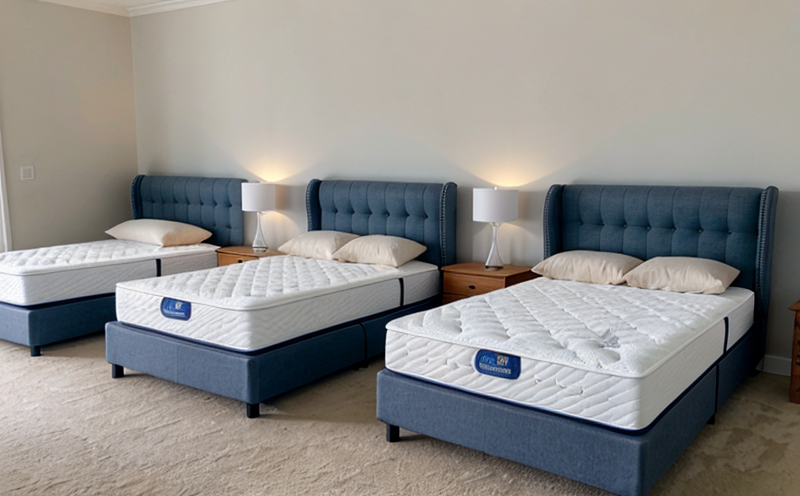BS 7177 Specification for Resistance to Ignition of Mattresses Testing
The BS 7177 specification is a critical standard in the furniture testing sector, particularly applicable to beds and mattresses. It serves as a benchmark for ensuring that mattresses can resist ignition under specific conditions, thereby enhancing safety standards in residential settings.
This test evaluates how well a mattress resists catching fire when exposed to an open flame or other sources of ignition. The standard is designed to protect against the risk of accidental fires due to smoking materials, candles, or faulty electrical devices left near sleeping areas. By adhering to BS 7177, manufacturers can demonstrate their commitment to safety and meet regulatory requirements.
The test procedure involves placing a specimen mattress into an apparatus that simulates the conditions under which ignition might occur in a domestic setting. The apparatus is designed to ensure consistent and repeatable results, allowing for accurate assessment of each sample’s resistance to ignition. This process helps identify any potential hazards early on, ensuring product quality and compliance.
The importance of this specification cannot be overstated, especially given the increasing focus on fire safety in residential furniture. By implementing BS 7177 testing during the design and manufacturing phases, companies can minimize risks associated with faulty products reaching the market. This not only protects consumers but also enhances brand reputation through demonstrated commitment to safety.
In addition to protecting end users, adhering to this standard benefits manufacturers by providing a clear set of guidelines for producing safer mattresses. It encourages innovation in fire-resistant materials and technologies while fostering industry-wide consistency. As regulations evolve, staying compliant with standards like BS 7177 ensures long-term market success.
The test process itself is straightforward but rigorous. Specimens are prepared according to specified dimensions and then placed into an apparatus designed to simulate real-world ignition scenarios. The apparatus includes a flame source that applies heat to one end of the mattress, allowing researchers to observe its behavior over time. Various parameters such as temperature rise, smoke production, and flame spread rate are measured during this process.
After completing the test, results are analyzed based on predefined acceptance criteria outlined in BS 7177. These criteria ensure that mattresses meet minimum safety requirements regarding resistance to ignition. Compliance with these standards is crucial for maintaining product integrity and ensuring public trust.
In conclusion, implementing the BS 7177 specification for mattress testing offers numerous benefits. It enhances fire safety measures by identifying potential risks early on, promotes innovation in fire-resistant materials, ensures consistent quality across products, and builds consumer confidence through demonstrated compliance with recognized standards.
Scope and Methodology
| Parameter | Description |
|---|---|
| Test Specimen Size | The test specimen should be a full-size mattress, measuring approximately 92.7 x 185.4 cm (36.5 x 73 inches). |
| Flame Source | An open flame source that provides a consistent heat input of at least 50 kW/m². |
| Test Duration | The test should run for no less than 3 minutes after ignition. |
| Temperature Measurement | Temperature sensors are placed at various points on the mattress to monitor temperature rise during testing. |
| Smoke Production Monitoring | The amount of smoke produced by the mattress is quantified using specialized smoke detectors. |
| Fuel Consumption Rate | This measures how quickly fuel (if any) consumed during testing is used up. |
| Flame Spread Rate | The rate at which flames spread across the surface of the mattress is recorded and analyzed. |
Industry Applications
The BS 7177 specification finds extensive application in various segments within the furniture industry. Its primary use is in manufacturing beds and mattresses, ensuring that these products meet stringent safety standards before they reach consumers.
Manufacturers who adhere to this standard can ensure their products comply with legal requirements imposed by government bodies worldwide. This compliance helps mitigate potential liabilities related to product defects or accidents involving fire hazards.
In addition to enhancing marketability, implementing BS 7177 also aids in fostering a culture of safety within the industry. It promotes best practices for material selection and manufacturing processes, ultimately leading to higher quality products that contribute positively towards overall public health and well-being.
Furthermore, by adopting this specification early on in the product development cycle, companies gain valuable insights into areas where improvements can be made. This proactive approach enables them to stay ahead of changing regulations while continuously improving their offerings.
Competitive Advantage and Market Impact
Compliance with BS 7177 not only ensures safety but also provides significant competitive advantages for manufacturers. In today’s market, consumers are increasingly demanding safer products that meet high standards of quality and reliability.
By adhering to this specification, companies can differentiate themselves from competitors by offering mattresses that exceed basic regulatory requirements. This differentiation translates into better customer satisfaction and loyalty, which in turn boosts brand reputation and sales performance.
Maintaining compliance with evolving standards also positions firms as industry leaders committed to innovation and improvement. Such leadership attracts investors and partners looking for reliable long-term collaborators. Additionally, it fosters trust among stakeholders, including suppliers and customers, enhancing overall business sustainability.





